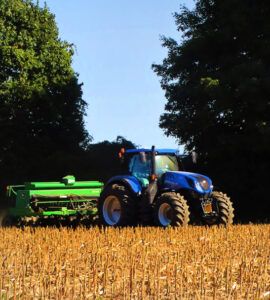Cover Crops
What are Cover Crops?
Cover crops are used after row crops are harvested or in between harvest and re-planting to promote general soil health in agricultural lands. Soil health is important as it means less erosion, less compaction, greater nutrient cycling, increased microbial activity and improved water infiltration into the soil, improving overall water quality. Cover crops can also contribute to weed suppression and interruption of pest cycles, while attracting beneficial insects.
Another added benefit is that cover crops can reduce the use and cost of fertilizer by supplying sufficient nutrients to the soil. When the cover crop “season” is over, crops can be harvested and used as additional forage.
Cover crops are being used on farms in our region to minimize erosion, maximize nutrient uptake in the fall, improve soil heath, and increase organic matter and field trafficability. As fertilizer prices continue to increase and producers aim to reduce N loss to the environment, they are asking about the nitrogen (N) benefits of cover crops for corn silage systems.
To begin addressing these issues and with the aim of stimulating cover crop implementation on corn silage acres in New York, the Upper Susquehanna Coalition (USC) is piloting a Cover Crop Initiative with the assistance of funding from the NYS Department of Environmental Conservation.
To find out more about the USC Cover Crop Initiative please contact your local SWCD.
Online Tools and Resources:
Maryland Department of Agriculture Cover Crop Program
USDA NRCS: Cover Crops and Soil Health
Cover Crop Decision Tool
Cover Crop Guide for New York Vegetable Growers
Building Soils for Better Crops, 3rd Edition
Sustainable Agriculture Research and Education: Cover Crops for Sustainable Crop Rotations
New York on Farm Research Partnership: Double Crops
New York on Farm Research Partnership: Cover Crops
Sustainable Agriculture Research and Education
Cornell University Nutrient Management Spear Program
Fact Sheets
Forage Radishes
Fertility Management of Winter Wheat
Effectiveness:
Addition of New Cover Crop Species with Nitrogen Reduction Efficiencies

